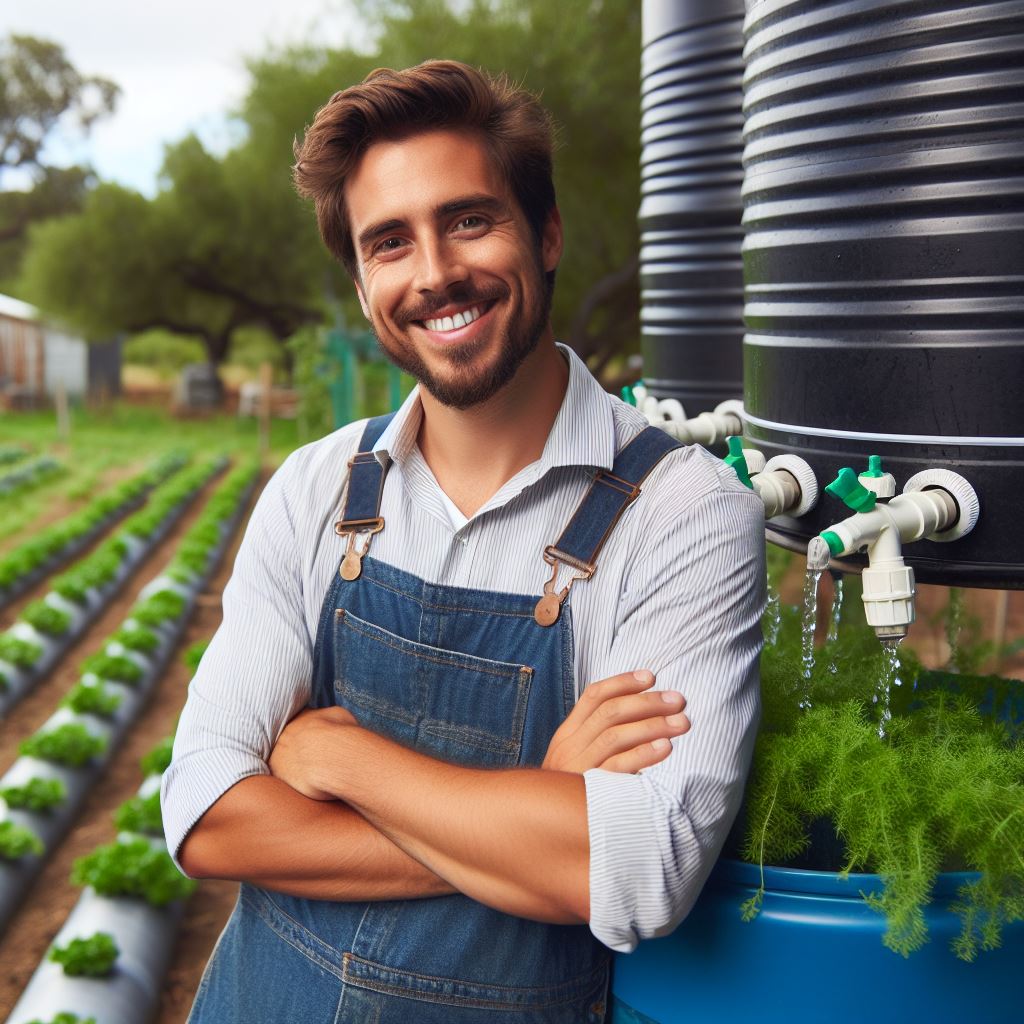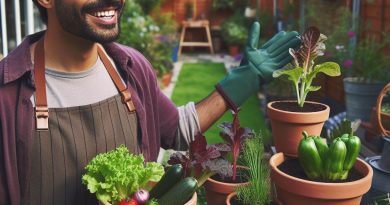Eco-Friendly Farming: Water Conservation Tricks
Last Updated on February 5, 2024
Introduction
A. Eco-friendly farming and its importance
Eco-friendly farming plays a vital role in preserving the environment and sustaining our agricultural practices.
It focuses on sustainable methods that minimize the use of harmful chemicals and promote natural processes.
One critical aspect of eco-friendly farming is water conservation, which is essential due to its scarcity in many regions worldwide.
By implementing various water-saving techniques, farmers can reduce their water usage and contribute to a more sustainable future.
In this blog post, we will explore some effective water conservation tricks that can be applied in eco-friendly farming.
B. Water conservation & Climate change
Water conservation is becoming increasingly crucial as climate change has led to water shortages in numerous areas.
Eco-friendly farming techniques aim to address this issue by maximizing water efficiency without compromising crop yields.
By adopting practices like drip irrigation, mulching, and rainwater harvesting, farmers can optimize their water usage and minimize waste.
Drip irrigation delivers water directly to the plants’ roots, reducing evaporation and water runoff.
Mulching involves covering the soil with organic materials to retain moisture and prevent weed growth.
Additionally, collecting and storing rainwater can provide an alternative water source during dry spells.
C. Proper soil management techniques
Furthermore, implementing proper soil management techniques such as cover cropping and crop rotation can enhance water retention in the soil.
Cover cropping involves planting specific crops to protect and enrich the soil, preventing water runoff.
Crop rotation helps maintain soil health, improving its ability to retain water and nutrients.
These methods not only conserve water but also contribute to healthier soil and increased biodiversity.
Basically, eco-friendly farming is crucial for sustainable agriculture, and water conservation is a key component of this practice.
By adopting various techniques such as drip irrigation, mulching, rainwater harvesting, and soil management strategies, farmers can minimize their water usage and contribute to a more environmentally friendly farming system.
The Importance of Water Conservation in Farming
A. Water crisis and its impact on farming
Water conservation is of utmost importance in farming as it helps in sustainable agriculture.
The water crisis has a significant impact on farming, leading to reduced crop yield and economic losses.
The increasing water scarcity is closely linked to climate change, exacerbating the challenges faced by farmers.
Effective water conservation tricks
Here are some effective water conservation tricks that can be implemented in farming:
- Efficient Irrigation: Switching from traditional flood irrigation to more advanced methods like drip irrigation can minimize water wastage.
- Soil Management: Employing techniques such as mulching and cover cropping helps retain soil moisture, reducing the need for excessive watering.
- Crop Selection: Opting for drought-tolerant crops and utilizing crop rotation techniques can reduce water requirements in farming.
- Rainwater Harvesting: Capturing rainwater through systems like rain barrels and ponds provides an additional water source for irrigation purposes.
- Precision Farming: Using modern technologies like sensors and drones can ensure precise water application, avoiding overwatering.
- Water Recycling: Implementing systems to collect and treat runoff water can enable its reuse, reducing overall water consumption on the farm.
- Efficient Water Storage: Investing in proper water storage systems such as tanks and reservoirs ensures water availability during dry spells.
- Polyculture Farming: Planting a diverse range of crops together helps create a balanced ecosystem, reducing pest attacks and water needs.
- Composting: Adding organic matter to the soil through composting improves its water-holding capacity, promoting healthier plant growth.
- Education and Training: Educating farmers about the importance of water conservation and providing training on efficient irrigation techniques is crucial.
B. The connection between water scarcity and climate change
The connection between water scarcity and climate change is evident.
As temperatures rise and rainfall patterns become unpredictable, the availability of water for farming becomes increasingly limited.
Climate change-induced droughts and extreme weather events further intensify the water crisis, making it essential for farmers to adopt water-saving practices.
Water scarcity not only affects crop irrigation but also impacts livestock farming.
Animals require adequate water for drinking, hygiene, and cooling purposes.
Therefore, implementing water conservation measures in livestock farming, such as using efficient watering systems and minimizing wastage, is equally crucial.
Moreover, sustainable water management in agriculture can contribute to mitigating climate change.
By conserving water and reducing energy requirements for irrigation, farmers can help reduce greenhouse gas emissions.
Additionally, utilizing water resources efficiently can prevent the depletion of freshwater ecosystems, ensuring their long-term viability.
Generally, water conservation plays a vital role in ensuring sustainable farming practices.
Implementing various techniques like efficient irrigation, soil management, and water recycling can help farmers cope with the water crisis.
Recognizing the connection between water scarcity and climate change emphasizes the need for immediate action to preserve this precious resource.
By adopting eco-friendly farming practices, farmers can contribute to a more resilient agricultural system and a greener future.
Read: Urban Farm Water-Saving: Top 5 Effective Methods
Adopting Sustainable Irrigation Techniques
In order to conserve water in eco-friendly farming practices, adopting sustainable irrigation techniques is crucial.
These techniques focus on efficient water usage, minimizing waste, and reducing environmental impact.
A. Drip irrigation systems: benefits, operation, and maintenance
Drip irrigation is a popular sustainable irrigation technique that offers several benefits.
It involves the slow and precise application of water directly to plant roots, minimizing evaporation and ensuring optimum water uptake.
The benefits of drip irrigation systems include:
- Efficient water usage: Drip irrigation reduces water wastage by delivering water directly to plant roots.
- Reduced weed growth: Since water is targeted at plant roots, weed growth is minimized as weeds receive less water.
- Precise nutrient delivery: Drip systems can also include nutrient delivery, ensuring plants receive the right amount of nutrients.
The operation of a drip irrigation system is fairly simple.
Water is conveyed through a network of tubes and emitters that release water at a controlled rate.
Maintenance involves regular inspection for leaks, cleaning or replacing clogged emitters, and adjusting water flow as needed.
B. Micro-irrigation techniques: advantages and implementation
Micro-irrigation techniques take sustainable irrigation a step further by using low-volume irrigation methods such as micro-sprinklers and micro-jets.
These techniques have various advantages:
- Water efficiency: Micro-irrigation techniques deliver water directly to the root zone, minimizing evaporation and runoff.
- Reduced disease risks: Water is applied at a low rate, reducing the chance of plant diseases caused by excessive moisture.
- Easy installation: Micro-irrigation systems are relatively easy to install and can be adapted to different crop types and field conditions.
Implementing micro-irrigation techniques involves designing an appropriate system, including layout planning, emitter selection, and setting up filtration systems.
Regular maintenance includes checking and cleaning emitters, monitoring water pressure, and repairing any leaks or damages.
C. Rainwater harvesting: collecting and using rainwater efficiently
Rainwater harvesting is an effective way to conserve and utilize water resources sustainably.
By collecting and storing rainwater, farmers can reduce their reliance on other sources while also reducing stormwater runoff.
Some key considerations for rainwater harvesting include:
- Roof collection: Rainwater can be collected from rooftops using gutters and downspouts, and then stored in tanks or reservoirs.
- Water treatment: Depending on the use, rainwater may require treatment before irrigation. Simple filtration systems can be used.
- Efficient utilization: Stored rainwater can be used during dry spells or combined with other irrigation techniques for optimal water use.
Proper maintenance of rainwater harvesting systems includes regular cleaning of gutters and filters, ensuring tanks are sealed to prevent contamination, and checking for any cracks or damages.
Essentially, adopting sustainable irrigation techniques such as drip irrigation, micro-irrigation, and rainwater harvesting is essential for eco-friendly farming.
These techniques contribute to efficient water usage, minimize waste, and promote environmental sustainability in agricultural practices.
Read: Small Garden? Big Savings: Water Efficiency Tips
Crop Selection and Rotating Methods for Water Conservation
A. Choosing drought-tolerant crops: characteristics and benefits
Crop selection and rotating methods are essential for water conservation in eco-friendly farming.
Choosing drought-tolerant crops can greatly contribute to water conservation efforts.
These crops have specific characteristics that make them capable of thriving with minimal water supply.
By planting drought-tolerant crops, farmers can reduce their water usage significantly.
- Drought-tolerant crops have deep roots that enable them to access water resources from deeper layers of soil.
- These crops have a higher level of water-use efficiency, meaning they can produce a greater yield with less water.
- By choosing such crops, farmers can optimize water usage and minimize wastage, leading to sustainable farming practices.
B. Intercropping: optimizing water usage through plant combinations
Another effective method for water conservation is intercropping, which involves planting different crop species together.
Intercropping optimizes water usage by creating a beneficial plant combination where one crop serves as a companion to another.
- For example, combining crops with different root depths can allow them to access water from different soil layers, maximizing water absorption.
- Intercropping can also reduce water evaporation from the soil surface by creating a microclimate that retains moisture.
- Additionally, certain crop combinations can inhibit the growth of pests and diseases, reducing the need for water-intensive pest control measures.
C. Crop rotation: improving soil health and minimizing water requirements
Crop rotation is another crucial approach to conserve water while maintaining soil health in eco-friendly farming.
This practice involves systematically changing the crops grown in a particular area over time, benefiting both the soil and water conservation efforts.
- Crop rotation helps break pest and disease cycles, reducing the need for chemical interventions and the subsequent water requirements for their application.
- By rotating crops, farmers can also improve the soil’s organic matter and nutrient content, enabling it to retain water more effectively.
- Furthermore, different crops have varying water requirements. By rotating crops with different water needs, farmers can minimize overall water usage.
In general, crop selection and rotating methods play a significant role in water conservation for eco-friendly farming.
Choosing drought-tolerant crops, practicing intercropping, and implementing crop rotation strategies can optimize water usage, improve soil health, and ensure sustainable farming practices.
By adopting these techniques, farmers can contribute to water conservation efforts and promote a more environmentally friendly agricultural system.
Read: Marigolds: More Than Just Pretty

Soil Management Practices for Water Retention
Water conservation is a critical aspect of eco-friendly farming.
By implementing efficient soil management practices, farmers can reduce water usage and enhance sustainability in their operations.
There are several techniques that can be employed to improve water retention in the soil:
A. Mulching: Types, Benefits, and Application Methods
Mulching involves covering the soil surface with organic or synthetic materials to conserve moisture.
There are various types of mulches, including:
- Organic Mulch: Made from natural materials such as straw, wood chips, or compost. It helps retain soil moisture by reducing evaporation.
- Synthetic Mulch: Made of plastic or polyethylene. It prevents water loss by acting as a barrier between the soil and the atmosphere.
The benefits of mulching in water conservation are significant:
- Reduces Evaporation: Mulching blocks direct sun exposure, keeping the soil surface cooler and preventing water from evaporating.
- Controls Weed Growth: Mulch inhibits weed germination and growth, reducing competition for water resources.
- Enhances Soil Fertility: Organic mulches decompose over time, enriching the soil with essential nutrients.
To effectively apply mulch:
- Prepare the Soil: Remove weeds and apply a layer of compost or fertilizer to ensure adequate soil nutrition.
- Apply Mulch: Spread a layer of mulch around plants, leaving a small space around stems to prevent rot.
- Monitor Moisture: Regularly check soil moisture levels and irrigate as needed, making adjustments based on mulch’s water retention ability.
B. Cover Cropping: Preventing Water Evaporation and Improving Soil Structure
Cover cropping involves planting a secondary crop alongside the main crop to provide soil coverage and protect against water loss.
This practice offers multiple benefits:
- Reduced Evaporation: The cover crop canopy shields the soil surface, reducing the direct impact of the sun’s rays and minimizing evaporation.
- Improved Soil Structure: The cover crop’s roots create channels in the soil, allowing water to infiltrate and enhancing overall soil structure.
- Enhanced Soil Health: Cover crops add organic matter to the soil, promoting microbial activity and nutrient cycling.
C. Conservation Tillage: Reducing Water Runoff and Increasing Water Infiltration
Conservation tillage refers to minimum disturbance of the soil during cultivation.
This method significantly contributes to water conservation:
- Reduced Water Runoff: By leaving crop residues on the soil surface, conservation tillage prevents water from flowing away and helps it penetrate into the ground.
- Increased Water Infiltration: The presence of crop residues improves soil structure, allowing water to infiltrate rather than becoming runoff.
- Improved Soil Health: Conservation tillage minimizes soil erosion, enhances organic matter content, and promotes beneficial soil organisms.
Implementing these soil management practices can revolutionize water conservation in farming, leading to more sustainable agriculture.
In essence, mulching, cover cropping, and conservation tillage are essential techniques for water conservation in eco-friendly farming.
By reducing evaporation, preventing water runoff, and improving soil infiltration, these practices contribute to sustainable agriculture and protect our precious water resources.
Read: Herbal Mixes to Protect Your Plants
Smart Water Monitoring and Management
A. Utilizing sensor technology for precise irrigation scheduling
Advanced sensor technology enables precise irrigation scheduling on farms.
Moisture sensors in soil precisely measure water content.
This data helps determine optimal irrigation amounts and timing to minimize overwatering.
Sensors also track changing weather patterns and plant water needs.
B. Data analysis and predictive models for water usage optimization
Data analysis provides insights for predicting future water requirements.
Complex models factor in crop types, growth stages, weather forecasts, and soil conditions.
This enables highly customized irrigation plans.
C. Efficient management of water sources and storage facilities
Efficient systems optimize on-farm water usage. Flow meters track water withdrawn from wells or storage ponds.
Pressure sensors on pipes detect leaks. Weather stations monitor precipitation.
Software aggregates data to identify waste and prioritize fixes.
Smart systems allow remote monitoring and control via mobile apps. Real-time adjustments optimize water application.
Thoughtful design of water storage and conveyance maximizes resources.
Lined ponds prevent seepage. Underground tanks provide buffered capacity.
Pipes must be sized appropriately for each application.
Gravity-fed drip irrigation delivers water precisely to roots.
Proper storage capacity and distribution uniformity ensure water security.
In essence, technology, data-driven management, and robust infrastructure work together for sustainable water use on eco-friendly farms.
Precise monitoring, predictive models, and efficient systems conserve this precious resource.
Promoting Eco-Friendly Farming Practices in the Community
Water conservation in agriculture is a crucial aspect of eco-friendly farming practices that must be prioritized.
By promoting awareness about the importance of water conservation, collaborating with local farmers and organizations, and engaging in educational programs and workshops, we can make a significant impact on our environment.
A. Raising Awareness about the Need for Water Conservation in Agriculture
- Spread the word about the alarming rate of water depletion in agriculture.
- Highlight the impact of water scarcity on crop yields and overall food production.
- Advocate for sustainable irrigation methods such as drip irrigation or precision watering.
- Encourage farmers to monitor their water usage and adopt efficient water management strategies.
- Emphasize the long-term benefits of water conservation for both farmers and the community.
B. Collaborating with Local Farmers and Organizations
- Establish partnerships with local farmers to promote eco-friendly farming practices.
- Encourage farmers to implement water-saving techniques such as rainwater harvesting.
- Organize regular meetings and workshops to share knowledge and experiences.
- Work with agricultural associations to develop guidelines for water-efficient farming.
- Facilitate the exchange of ideas and best practices among farmers to enhance water conservation efforts.
C. Engaging in Educational Programs and Workshops
- Conduct educational programs in schools to raise awareness among future generations.
- Organize field trips to farms that practice eco-friendly and water-efficient techniques.
- Hold workshops for farmers to learn about new technologies and methodologies.
- Showcase success stories of farmers who have adopted sustainable water management practices.
- Highlight the economic and environmental benefits of eco-friendly farming practices.
By actively promoting eco-friendly farming practices, we can reduce water wastage in agriculture and ensure a sustainable future for generations to come.
Water conservation should be a priority in every farming community, and by working together, we can make a significant difference.
Let us come together, raise awareness, collaborate with local farmers and organizations, and engage in educational programs to protect our most valuable resource – water.
Conclusion
In this blog post, we have discussed several water conservation tricks that are essential for eco-friendly farming.
By implementing these practices, farmers can play a crucial role in preserving water resources and ensuring a sustainable future for agriculture.
We have learned the importance of using drip irrigation systems, which deliver water directly to the roots of plants, minimizing wastage.
Another effective trick is mulching, which helps retain moisture in the soil and reduce evaporation.
Furthermore, smart scheduling and monitoring of irrigation can significantly reduce water usage.
By understanding the water requirements of different crops and adjusting irrigation accordingly, farmers can optimize water usage and prevent overwatering.
It is also essential to collect and store rainwater for agricultural purposes.
Installing rain barrels and using them during dry periods can help reduce the dependence on groundwater and other water sources.
Recycling and reusing water should also be a priority.
Graywater, which is wastewater from sources like sinks and showers, can be treated and used for irrigation.
This practice not only conserves water but also reduces the strain on freshwater resources.
In closing, incorporating these water conservation tricks in eco-friendly farming is crucial for the sustainability of agriculture.
As we face water scarcity and environmental challenges, it is essential for farmers and agricultural practitioners to adopt these practices.
By doing so, we contribute to the preservation of our water resources and ensure a prosperous future for farming and food production.
Start implementing these tricks in your own farming endeavors and be a part of the change.


